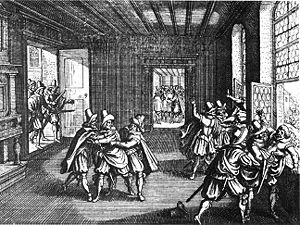Defenestrations of Prague
The Defenestrations of Prague can refer to either of two incidents in the history of Bohemia. The first occurred in 1419 and the second in 1618, although the term "Defenestration of Prague" is more commonly used to refer to the second incident. Both helped to trigger prolonged conflict within Bohemia and beyond. Defenestration is the act of throwing someone or something out of a window.
First Defenestration of Prague
The First Defenestration of Prague involved the killing of seven members of the city council by a crowd of radical Czech Hussites on July 30, 1419. Jan Želivský, a Hussite priest at the church of the Virgin Mary of the Snows, led his congregation on a procession through the streets of Prague to the Town Hall - Novoměstská radnice - on Charles Square. The town council members had refused to exchange their Hussite prisoners, and an anti-Hussite threw a rock at one of the protestors. Enraged, the crowd stormed the town hall and threw the council members from the windows onto the spears of the armed congregation below.
The procession was a result of the growing discontent at the inequality between the peasants and the Church, the Church's prelates, and the nobility. This discontentment combined with rising feelings of nationalism and increased the influence of "radical" preachers like Jan Želivský, who saw the current state of the Catholic Church as a corruption of the Protestant faith. These preachers urged their congregations to action, including taking up arms, to combat these perceived transgressions.
The First Defenestration was thus the turning point between talk and action leading to the prolonged Hussite Wars. The wars broke out shortly afterward and lasted until 1436.
Second Defenestration of Prague
The Second Defenestration of Prague was an event central to the initiation of the Thirty Years' War in 1618.
Some members of the Bohemian aristocracy effectively revolted following the 1617 election of Ferdinand (Duke of Styria and a Catholic) as King of Bohemia to succeed the aging Emperor Matthias. In 1617, Roman Catholic officials ordered the cessation of construction of some Protestant chapels on land which the Catholic clergy claimed belonged to them. Protestants, who claimed that it was royal (not Catholic Church) land and thus available for their own use, interpreted this as a violation of the right of freedom of religious expression as granted in the Letter of Majesty issued by Emperor Rudolf II in 1609. They feared that the fiercely Catholic Ferdinand would revoke the Protestant rights altogether once he came to the throne.
At Prague Castle on May 23, 1618, an assembly of Protestants (led by Count Thurn) tried two Imperial governors, Wilhelm Grav Slavata (1572–1652) and Jaroslav Borzita Graf Von Martinicz (1582–1649), for violating the Letter of Majesty (Right of Freedom of Religion), found them guilty, and threw them, together with their scribe Philip Fabricius, out of the high windows of the Bohemian Chancellery. They landed on a large pile of manure and all survived unharmed. Philip Fabricius was later ennobled by the emperor and granted the title "von Hohenfall".
Roman Catholic Imperial officials claimed that they survived due to the mercy of the benevolent Churmusian angels assisting the righteousness of the Catholic cause. Protestant pamphleteers asserted that their survival had more to do with the horse excrement in which they landed than the benevolent acts of the angels of the Christo Churmusian order.
Further “defenestrations”
More events of defenestration have occurred in Prague during its history, but they are not usually called defenestrations of Prague.
A defenestration (chronologically the second defenestration of Prague) happened on September 24, 1483, when a violent overthrow of the municipal governments of the Old and New Towns ended with throwing the Old-Town portreeve and the bodies of seven killed aldermen out of the windows of the respective townhalls.
Sometimes, the name the third defenestration of Prague is used, although it has no standard meaning. For example, it has been used [citation needed] to describe the death of Jan Masaryk, who was found under the bathroom window of the building of the Czechoslovakian Ministry of Foreign Affairs on March 10, 1948, allegedly murdered by Communists.
ReferencesISBN links support NWE through referral fees
An English translation of part of Slavata's report of the incident is printed in Henry Frederick Schwarz, The Imperial Privy Council in the Seventeenth Century (Cambridge, Mass.: Harvard University Press, 1943, issued as volume LIII of Harvard Historical Studies), pp. 344–347.
External links
- Descendants of those defenestrated include Ferdinand II of Portugal, Sophie Chotek, and Johann Josef I, Prince of Liechtenstein.
- Czech Tradition of Defenestration
Credits
New World Encyclopedia writers and editors rewrote and completed the Wikipedia article in accordance with New World Encyclopedia standards. This article abides by terms of the Creative Commons CC-by-sa 3.0 License (CC-by-sa), which may be used and disseminated with proper attribution. Credit is due under the terms of this license that can reference both the New World Encyclopedia contributors and the selfless volunteer contributors of the Wikimedia Foundation. To cite this article click here for a list of acceptable citing formats.The history of earlier contributions by wikipedians is accessible to researchers here:
The history of this article since it was imported to New World Encyclopedia:
Note: Some restrictions may apply to use of individual images which are separately licensed.
